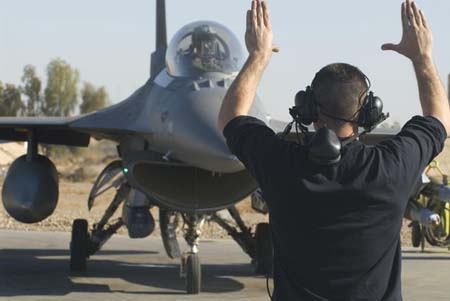Hou se Armed Services Committee head Ike Skelton (D-Mo.) says, “I cannot help but conclude that a significant factor in the current strain on the Air Force is a lack of people.” Skelton was addressing the Air Force’s two top leaders at his Feb. 27 hearing on the Fiscal 2009 Air Force budget proposal when he asserted that USAF’s unfunded requirements list “suggests as much, identifying a requirement for $385 million to add back almost 19,000 airmen, split between the active duty and reserve.” Indeed, the service’s URL lists a Total Force end strength increase as its No. 4 item, below four additional F-22s and above additional C-130Js and C-17s. In its justification, the service says that “glide sloping” to the Fiscal 2009 total of 316,600 active airmen would produce “a critical capability gap,” and jeopardize support for emerging missions, such as Africa Command, a larger ground force, and USAF’s own new Cyber Command, and the Quadrennial Defense Review-directed 86 combat wings, known as the Required Force. As Skelton pointed out, USAF leaders “can’t have it both ways.” Either they support the 2009 budget with its continued personnel drawdown or they don’t. Air Force Secretary Michael Wynne told the lawmakers that unofficially he supports the URL increase to “hedge our bets.” Gen. Michael Moseley, Chief of Staff, responded that discussions with DOD are ongoing, but, he is now “more concerned” that continuing down to 316,000 is not the right course. In their joint statement, the two leaders said, “Reducing Air Force end strength further, coupled with [in-lieu-of] taskings for the foreseeable future, carries considerable risks of ‘burning out’ our airmen in several critical expeditionary career fields as well as limiting our future national options to meet global mission requirements.”
se Armed Services Committee head Ike Skelton (D-Mo.) says, “I cannot help but conclude that a significant factor in the current strain on the Air Force is a lack of people.” Skelton was addressing the Air Force’s two top leaders at his Feb. 27 hearing on the Fiscal 2009 Air Force budget proposal when he asserted that USAF’s unfunded requirements list “suggests as much, identifying a requirement for $385 million to add back almost 19,000 airmen, split between the active duty and reserve.” Indeed, the service’s URL lists a Total Force end strength increase as its No. 4 item, below four additional F-22s and above additional C-130Js and C-17s. In its justification, the service says that “glide sloping” to the Fiscal 2009 total of 316,600 active airmen would produce “a critical capability gap,” and jeopardize support for emerging missions, such as Africa Command, a larger ground force, and USAF’s own new Cyber Command, and the Quadrennial Defense Review-directed 86 combat wings, known as the Required Force. As Skelton pointed out, USAF leaders “can’t have it both ways.” Either they support the 2009 budget with its continued personnel drawdown or they don’t. Air Force Secretary Michael Wynne told the lawmakers that unofficially he supports the URL increase to “hedge our bets.” Gen. Michael Moseley, Chief of Staff, responded that discussions with DOD are ongoing, but, he is now “more concerned” that continuing down to 316,000 is not the right course. In their joint statement, the two leaders said, “Reducing Air Force end strength further, coupled with [in-lieu-of] taskings for the foreseeable future, carries considerable risks of ‘burning out’ our airmen in several critical expeditionary career fields as well as limiting our future national options to meet global mission requirements.”
KC-46’s Refueling Boom Damaged While Refueling F-22s
July 8, 2025
A U.S. Air Force KC-46 tanker suffered damage to its boom while refueling F-22 Raptors off the coast of Virginia on July 8, Air & Space Forces Magazine has confirmed, with reported radio communication from the crew indicating the boom “detached.”